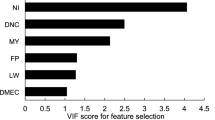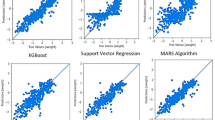Abstract
Support vector regression (SVR) and neural network (NN) models were used to predict average daily gain (ADG), feed efficiency (FE), and feed intake (FI) of broiler chickens during the starter period. Input variables for construction of the models were levels of dietary protein and branched-chain amino acids (BCAA; valine, isoleucine, and leucine). Starting with 241 lines, the SVR and NN models were trained using 120 data lines and the remainder (n = 121) was used as the testing set. The SVR models were developed using different kernel functions including: linear, polynomial (second and third order), radial basis function (RBF), and sigmoidal. In order to evaluate the SVR models, their performance was compared to that of multilayer perceptron (MLP)- and RBF-type NN models. Results indicated that MLP-type NN models were the most accurate in predicting the investigated output variables (R 2 for ADG in training and testing = 0.81 and 0.81; FE = 0.87 and 0.87; FI = 0.68 and 0.62). Among the different SVR kernels, best performance was achieved with the RBF (R 2 for ADG in training and testing = 0.76 and 0.76; FE = 0.85 and 0.87; FI = 0.46 and 0.48) and polynomial (third order) function (R 2 for ADG in training and testing = 0.77 and 0.77; FE = 0.85 and 0.87; FI = 0.46 and 0.39), whose prediction ability was better than that of the RBF-type NN (R 2 for ADG in training and testing = 0.75 and 0.75; FE = 0.82 and 0.82; FI = 0.41 and 0.39) models. Sigmoidal SVR models provided the poorest prediction. The work demonstrates that, through proper selection of kernel functions and corresponding parameters, SVR models can be considered as an alternative to NN models in predicting the response of broiler chickens to protein and BCAA. This type of model should also be applicable in poultry and other areas of animal nutrition.




Similar content being viewed by others
References
Smith TK, Austic RE (1978) The branched-chain amino acid antagonism in chicks. J Nut 108:1180–1191
Corzo A, Dozier WA III, Kidd MT (2008) Valine nutrient recommendations for Ross × Ross 308 broilers. Poult Sci 87:335–338
Cheng CS, Chen PW, Huang KK (2011) Estimating the shift size in the process mean with support vector regression and neural networks. Expert Syst Appl 38:10624–10630
Bishop CM (1996) Neural networks for pattern recognition. Oxford University Press, Oxford
Wu CH (1997) Artificial neural networks for molecular sequence analysis. Comput Chem 21:232–256
Haykin S (1998) Neural networks: a comprehensive foundation, 2nd edn. Prentice Hall PTR, Upper Saddle River
Vapnik V (1995) The nature of statistical learning theory. Springer, New York
Vapnik V (1998) Statistical learning theory. Wiley, New York
Anand A, Suganthan PN (2009) Multiclass cancer classification by support vector machines with class-wise optimized genes and probability estimates. J Theor Biol 259:533–540
Heaton J (2015) Artificial intelligence for humans, volume 3: deep learning and neural networks. Heaton Research Inc., Chesterfield
Deng N, Tian Y, Zhang C (2013) Support vector machines. Chapman & Hall, Boca Raton
StatSoft (2009) Statistica data analysis software system, version 7.1. StatSoft Inc., Tulsa
Lawrence S, Giles CL, Tsoi AC (1997) Lessons in neural network training: over-fitting may be harder than expected. Artif Intell 97:540–545
Ustun B, Melssen WJ, Oudenhuijzen M, Buydens LMC (2005) Determination of optimal support vector regression parameters by genetic algorithms and simplex optimization. Anal Chim Act 544:292–305
Thornley JHM, France J (2007) Mathematical models in agriculture, 2nd edn. CAB International, Wallingford
Bertsekas DP (1999) Nonlinear programming, 2nd edn. Athena Scientific, Cambridge
Belousov AI, Verzakov SA, VanFrese J (2002) A flexible classification approach with optimal generalization performance: support vector machines. Chemom Intell Lab Syst 64:15–25
Cristianini N, Shawe-Taylor J (2000) An introduction to support vector machines and other kernel-based learning methods. Cambridge University Press, Cambridge
Arlot S, Celisse A (2010) A survey of cross-validation procedures for model selection. Stat Surv 4:40–79
Polat K, Gunes S (2007) Breast cancer diagnosis using least square support vector machine. Digit Signal Process 17:694–701
Nazghelichi T, Aghbashlo M, Kianmehr MH (2011) Optimization of an artificial neural network topology using coupled response surface methodology and genetic algorithm for fluidized bed drying. Comput Electron Agric 75:84–91
Faridi A, Golian A, France J (2012) Evaluating the egg production behavior of broiler breeder hens in response to dietary nutrient intake during 31–60 weeks of age through neural network models. Can J Anim Sci 92:473–481
Faridi A, Sakomura NK, Golian A, Marcato SM (2012) Predicting body and carcass characteristics of 2 broiler chicken strains using support vector regression and neural network models. Poult Sci 91:3286–3294
Faridi A, Golian A, Heravi Mousavi A, France J (2014) Bootstrapped neural network models for analyzing the responses of broiler chicks to dietary protein and branched chain amino acids. Can J Anim Sci 94:79–85
Mariano FCMQ, Paixão CA, Lima RR, Alvarenga RR, Rodrigues PB, Nascimento GAJ (2013) Prediction of energy values of feedstuffs for broilers using meta-analysis and neural networks. Animal 7:1440–1445
Press WH, Teukolsky SA, Vetterling WT, Flannery BP (2007) Numerical recipes: the art of scientific computing, 3rd edn. Cambridge University Press, New York
King SL, Bennett KP, List S (2000) Modeling non-catastrophic individual tree mortality using logistic regression, neural networks, and support vector methods. Comput Electron Agric 27:401–406
Lemme A, Frackenpohl U, Petri A, Meyer H (2006) Response of male BUT big 6 turkeys to varying amino acid feeding programs. Poult Sci 85:652–660
Faridi A, Mottaghitalab M, Rezaee F, France J (2011) Narushin-Takma models as flexible alternatives for describing economic traits in broiler breeder flocks. Poult Sci 90:507–515
Park BC, Austic RE (2000) Isoleucine imbalance using selected mixtures of imbalancing amino acids in diets of the broiler chick. Poult Sci 79:1782–1789
Corzo A, Kidd MT, Dozier WA III, Vieira SL (2007) Marginality and needs of dietary valine for broilers fed certain all-vegetable diets. J Appl Poult Res 16:546–554
Lehninger AL (1981) Oxidative degradation of amino acids. Biochemistry, 2nd edn. Worth Publishers, New York, pp 559–586
Sashihara K, Miyamoto M, Ohgushi A, Denbow DM, Furuse M (2001) Influence of ketone body and the inhibition of fatty acid oxidation on the food intake of the chick. Br Poult Sci 42:405–408
Fisher H, Griminger P, Leveille GA, Shapiro R (1960) Quantitative aspects of lysine deficiency and amino acid imbalance. J Nutr 71:213–220
Burnham D, Emmans GC, Gous RM (1992) Isoleucine requirements of the chicken: the effect of excess leucine and valine on the response to isoleucine. Br Poult Sci 33:71–87
Waldroup PW, Kersey JH, Fritts CA (2002) Influence of branched-chain amino acid balance in broiler diets. Int J Poult Sci 1:136–144
Farran MT, Brabour EK, Ashkarian VM (2003) Effect of excess leucine in low protein diet on ketosis in 3-week-old male broiler chicks fed different levels of isoleucine and valine. Anim Feed Sci Technol 103:171–176
Barbour G, Latshaw JD (1992) Isoleucine requirements of broiler chicks as affected by the concentration of leucine and valine in practical diets. Br Poult Sci 33:561–568
Farran MT, Thomas OP (1990) Dietary requirements of leucine, isoleucine, and valine in male broilers during the starter period. Poult Sci 69:757–762
Tavernari FC, Lelis GR, Vieira RA, Rostagno HS, Albino LFT, Oliveira Neto AR (2013) Valine needs in starting and growing Cobb (500) broilers. Poult Sci 92:151–157
Farran MT, Thomas OP (1992) Valine deficiency: 1. The effect of feeding a valine-deficient diet during the starter period on performance and feather structure of male broiler chicks. Poult Sci 71:1879–1884
St-Pierre NR (2001) Integrating quantitative findings from multiple studies using mixed model methodology. J Dairy Sci 84:741–755
Faridi A, Gitoee A, France J (2015) A meta-analysis of the effects of nonphytate phosphorus on broiler performance and tibia ash concentration. Poult Sci 94:2753–2762
Acknowledgements
The Canada Research Chairs program (National Science and Engineering Council, Ottawa) is thanked for part funding.
Author information
Authors and Affiliations
Corresponding author
Ethics declarations
Conflict of interest
The authors declare that they have no conflict of interest.
Rights and permissions
About this article
Cite this article
Gitoee, A., Faridi, A. & France, J. Mathematical models for response to amino acids: estimating the response of broiler chickens to branched-chain amino acids using support vector regression and neural network models. Neural Comput & Applic 30, 2499–2508 (2018). https://doi.org/10.1007/s00521-017-2842-x
Received:
Accepted:
Published:
Issue Date:
DOI: https://doi.org/10.1007/s00521-017-2842-x




